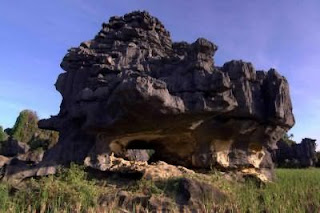 Karst Maros Pangkep region is the second largest and most beautiful in the world after the Karst region in South China. This clustered karst in Maros and Pangkep regency, South Sulawesi, Indonesia is partly included in Bantimurung Bulusaraung National Park area which spans over 43,750 acres.
Karst Maros Pangkep region is the second largest and most beautiful in the world after the Karst region in South China. This clustered karst in Maros and Pangkep regency, South Sulawesi, Indonesia is partly included in Bantimurung Bulusaraung National Park area which spans over 43,750 acres.The uniqueness of Karst Maros Pangkep region that are not found in other karst areas in Indonesia is the unique landscape and the typical of so-called tower karst. In the region, limestone hills are towering high with challenging cliffs. Together with the karst region in the Mountains Sewu, karst Maros Pangkep has been proposed as a site of world heritage to UNESCO since 2001.
 Karst Maros Pangkep Features
Karst Maros Pangkep FeaturesKarst Maros Pangkep is not just a row of rocks. In contrast to most of the karst area in other places which are generally conical-shaped hills, karst Maros Pangkep has shaped towers (tower karst) stand alone or in groups forming the cluster of towering limestone mountains. Among these hills, there are stretching plains with a flat surface. The towering hills are similar to the ones in South China and Vietnam.
There are at least 268 caves in Karst Maros Pangkep. Besides having
beautiful stalactites and stalagmites, the caves are also the habitat of
rare fauna and is a prehistoric site. Even the longest and deepest caves in Indonesia was found in the Karst Maros Pangkep. The deepest cave is a single well-shaped cave with a depth of 260 meters in Leang Leaputte. The longest cave is estimated to be found in Salukkan Kallang cave system, which extends for 27 km.
The caves formed as a result of leaching of carbonate rocks do not only produce a very beautiful cave ornaments, but also a place of refuge of the human species in the past. The caves were inhabited by humans and their cultures in the past. This is what now we call a “prehistoric cave”.
 There are several prehistoric caves found in karst Maros Pangkep area with many relics of prehistoric man such as:
There are several prehistoric caves found in karst Maros Pangkep area with many relics of prehistoric man such as:
- Cave Ara: toothed and winged arrowheads and pottery.
- Cave Awal: pottery
- Cave Batu Ejaya: shale blades, mikrolit,and pottery.
- Cave Bola Batu: shale blades, mikrolit, round stemmed arrowheads, and pottery.
- Cave Cadang: round stemmed arrowheads and pottery
- Cave Leang Balisao: shale blades and round stemmed arrowheads
- Cave Leang Burung (Bird) 1: round stemmed arrowheads and toothed and winged arrowheads
- Cave Leang Burung 2: coarse flakes and large blades
- Cave Leang Cekondo: shale blades and round stemmed arrowheads
- Cave Leang Karrasa: flakes of coarse and large blades and pottery
- Cave Leang-Leang: rock paintings and stone tools.
- Cave Sumpang Bita: rock paintings and stone tools.
 Unique biota live in there has a typical characteristic as result of
living in a dark cave. Transparent skin, narrowed eyes and even blind,
while the sensory organs developed rapidly. Arthropods, for example,
have long antennae as organs of taste. Among the findings are:
Unique biota live in there has a typical characteristic as result of
living in a dark cave. Transparent skin, narrowed eyes and even blind,
while the sensory organs developed rapidly. Arthropods, for example,
have long antennae as organs of taste. Among the findings are:- Transparent-bodied blind cave fish (Bostrycus sp.) From the Cave Saripa in Maros
- Blind scorpion cave, the only one in Southeast Asia
- Transparent-bodied shrimp(Cirolana marosina)
- Branch-nosed bat (Nyctmene cephalotes)
- Hipposideros dinops bats that live only in Sulawesi
- Spiders crab(Cancrocaeca xenomorph)
- Blind beetle of Coleoptera species
- Some types of unidentified cave crickets (Rhaphidophora sp.)
- The new species of spider cave , as big as a palm (Heteropoda beroni)
Currently, this area is undergoing a fairly heavy pressure, because the mining of limestone for cement, marble and other industries. The mining in Kars Maros region is threatening the availability of ground water in the surrounding area and also threaten the unique karst geomorphology and biodiversity.
Limestone mining activities carried out by large cement industries with a broad area of ??operations to 2,354.7 acres. In addition, at least there are 24 companies with a marble mining area exploitation of 15-25 acres each.
Hopefully, the mining activities do not compromise the uniqueness of karst maros Pangkep with its towering karst. That also goes with the archaeological and biodiversity contained therein.
Source:
http://discoverindonesia.net/

Beautiful landscapes! Especially the second to last picture...
ReplyDeleteI'm going to Sulawesi in a few months and I'd love to visit that place,
do you know its location?
Thank you,
Ale